El Banco Oriental de México
This bank opened its doors on 1 March 1900, under a concession granted on 19 September 1899 to Leopoldo Gavito, Soto y Compañía, Ignacio Rivero é Hijos, Agustín Mora, Lions Hermanos, S. Letona y Compañía and Ignacio Morales y Benítez. Its title suggested that the bank had regional ambitions from the very beginning.
The principal shareholder was Manuel Rivero Collada, together with a group of SpaniardsThe original board was President, Leopoldo Gavito, vocales propietarios, Ramón Gavito, Agustín Mora, Valentín Gómez, Isidoro Couttolenc, Adrian Reinaud and Matías Rivero, vocales suplentes Félix Martino, José M. Quintana, Tomás Furlong, Ildefonso de Aréchega, Santiago Couttolenc, José Desdier and Ignacio Rivero, comisarios propietarios, Ignacio Morales Benitez and Egidio Sánchez Gavito, comisarios suplentes, Juan N. Quitana and Alberto de la Fuente. The manager was Juan H. Meyer, cajero primero, Ricardo Serrano, cajeo segundo Alfonso Noriega, contador primero, Casto Rioja, contador segundo, Antonio Saracivar, contador tercero, Antonio Colín, auxiliar, José Pablo Almendaro and cobrador, Félix Arcante (Amigo de la Verdad, Puebla, Tomo II, Núm. 50, 3 March 1900. The bank’s original capital was $3,000,000 and its growth was so notable and rapid that on 25 July 1904 it saw the need to increase its capital to $6,000,000, and the new issue was completely subscribed. Another sign of the sound reputation it enjoyed is that its stocks were quoted on the Spanish Stock Exchange.
The bank had two branches in the state of Puebla, in Tezuitlan and Tehuacán and had correspondents throughout the country and abroad.
By 1908 the Banco Oriental had acquired almost all the shares that made up the capital of the Banco de Chiapas and the Banco de Oaxaca. In January 1909, it proposed to the Secretaría de Hacienda that the banks merge, expressing that "the object [...] it is to constitute a great regional bank with powerful elements that can serve, not only the interests of industry and commerce, but is in a position to inspire absolute confidence in the public". On 7 June the merger was formalized with the approval of the Secretaría de Hacienda. The Banco Oriental's share capital increased from $6,000,000 to $8,000,000 which allowed it to occupy the second place in the provincial banking system.
The bank opened a branch in Tlaxcala on 29 May 1910 with $5,000 in gold, $25,000 in silver and $30,000 in banknotesLa Antigua República, Tlaxcala, Novena Epoca, Núm. 21, 12 June 1910. Miguel Benítez Noriega was manager and Aurelio Rodríguez Fernández cajero contador.
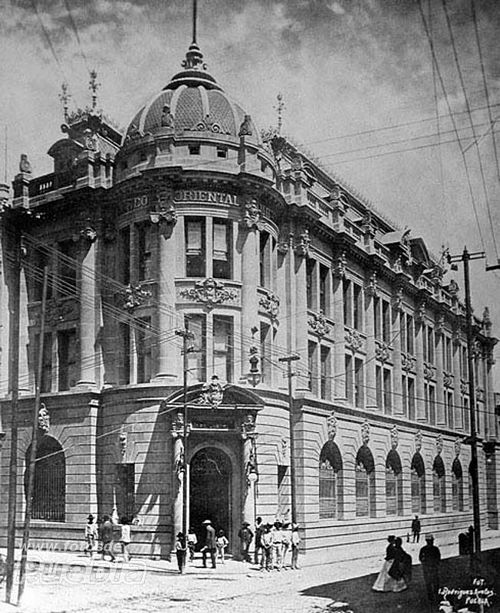
The bank's head offices in 1910
American Bank Note Company print runs
The ABNC engraved six special vignettes, charging the bank for just three as a discount on the total price. The portrait of Estevan de Antuñano (C 233) was taken from a Barcelona newspaperEstevan de Antuñano was born in Veracruz in 1792. Being the son of Spaniards, at the age of ten he was sent to Spain to study. Later, he spent several years in England where he became familiar with industrial work. In 1802 he returned to Veracruz and began to work in commerce. He established himself in Puebla in 1816, after marrying a rich heiress who was the owner of important haciendas in the Valle de Atlixco. After serving in the Republican militia he returned home to modernize the manufacturing industry. Despite opposition, he managed to successfully establish a seed separator plant in Veracruz and two large textile factories in Puebla.
He died in Puebla in 1847. A month before he died, the Congress of the State of Puebla declared him “Meritorious Founder of the Textile Industry”.
.
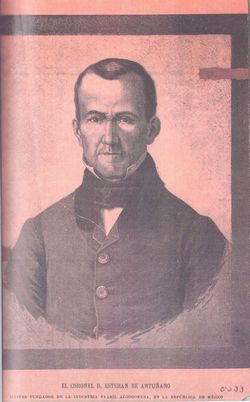
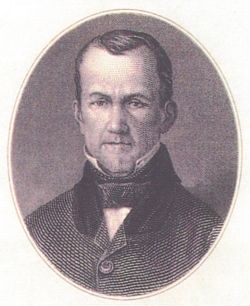
For the vignette of the Palacio Municipal (C 715) on the face of the $10 note the ABNC used a photograph of a plan of the Government building, with the notation, “13 September 1899 this building is not yet completed but it is hoped that from above drawing you can make vignette putting in clouds, people, carriage, etc.”. The ABNC used three photographs and a postcard of the Monument to the Heroes of Independencethis statue was unveiled in the old Paseo Bravo and is now situated at the junction of Avenida Juárez and [ ] (C 719)
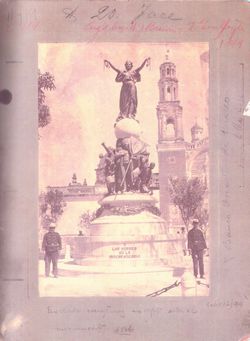
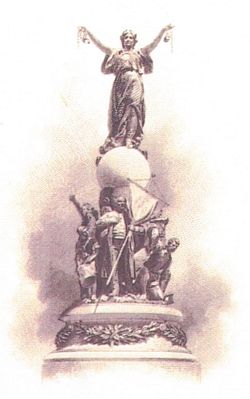
while on the photograph of the cathedral of Puebla (C 716) was added the notation “correct faulty perspective in towers”.
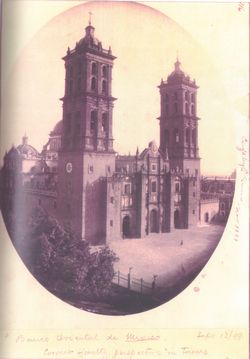
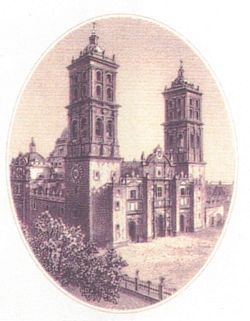
Another vignette was a bird’s eye view of Puebla (C 723).
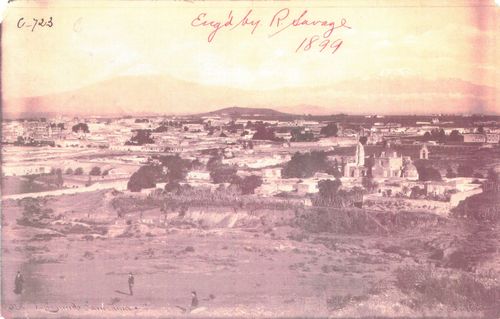
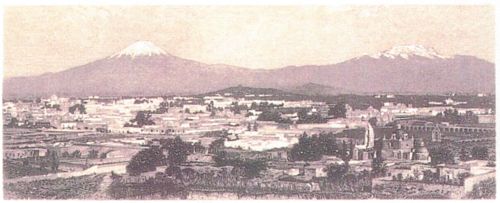
The city’s coat of arms, granted by Charles V, is engraved on all the reverse plates.
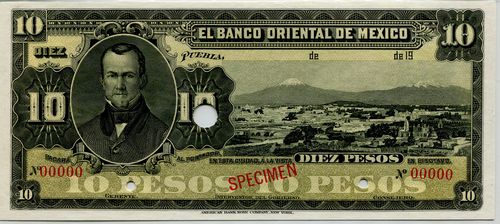
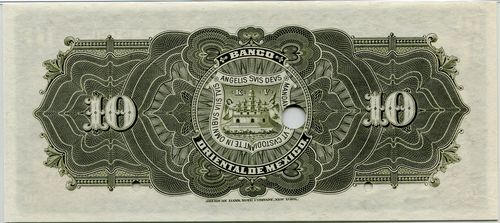
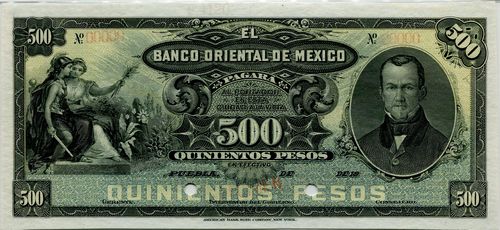
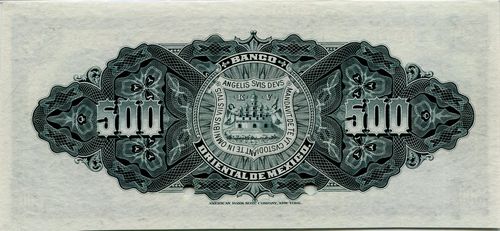
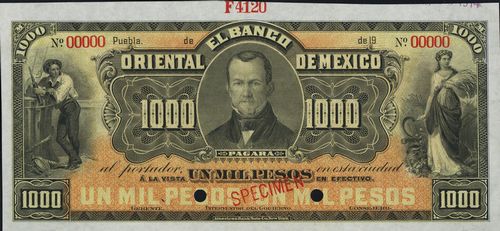
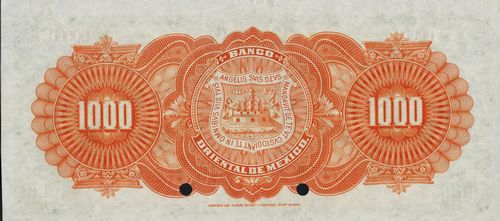
| Date | Value | Number | Series | from | to |
| October 1889 | $5 | 150,000 | 00001 | 150000 | |
| $10 | 75,000 | 00001 | 75000 | ||
| $20 | 25,000 | 00001 | 25000 | ||
| $50 | 10,000 | 00001 | 10000 | ||
| $100 | 8,000 | 0001 | 8000 | ||
| $500 | 1,000 | 1 | 1000 | ||
| $1000 | 700 | 1 | 700 |
In 1902 the ABNC altered the plates by erasing “de de 19 “ making the dateline just “Puebla”.
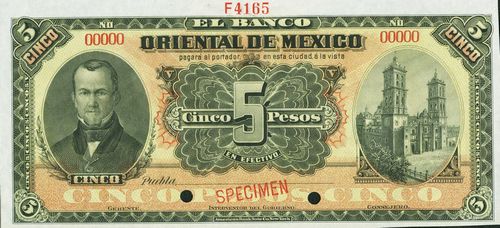
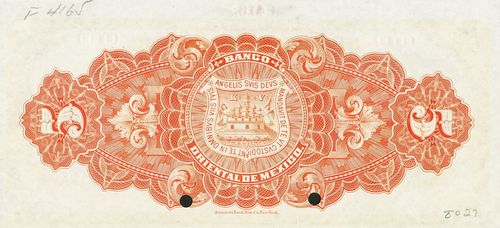
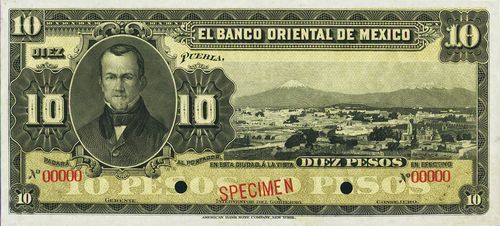
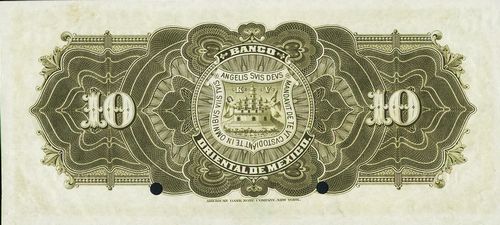
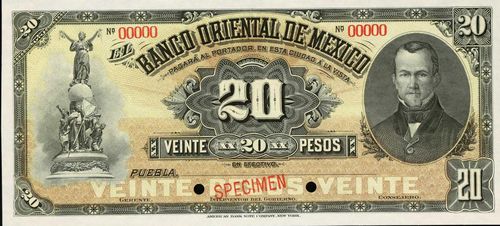
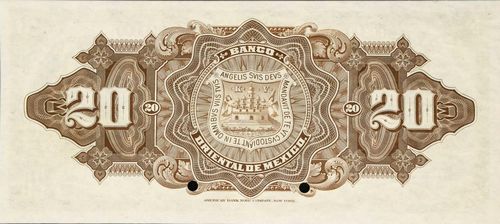
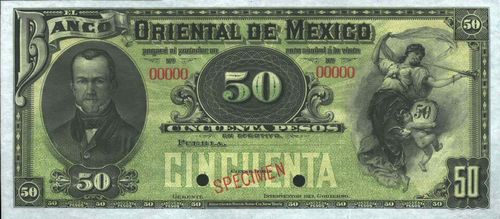
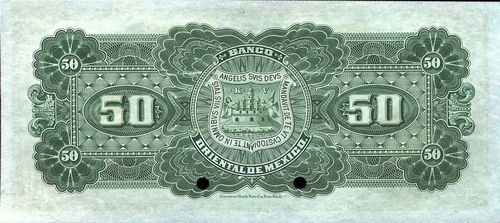
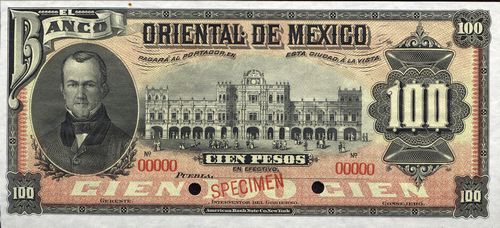
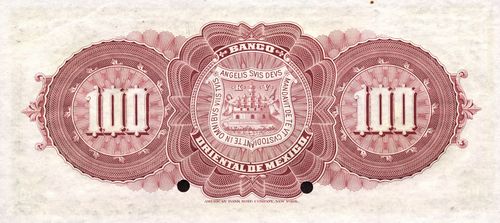
| Date | Value | Number | Series | from | to |
| September 1902 | $5 | 60,000 | 150001 | 210000 | |
| $10 | 30,000 | 75001 | 105000 | ||
| $20 | 20,000 | 25001 | 45000 | ||
| $50 | 20,000 | 10001 | 30000 | ||
| $100 | 10,000 | 8001 | 18000 |
On 6 December 1909 asked for a price for a new issue, and on 9 March 1910 ordered 346,250 notes in seven denominationsABNC, folder 300, Banco Oriental de México (1909-1914(June).
| Date | Value | Number | Series | from | to |
| March 1910 | $5 | 200,000 | 210001 | 410000 | |
| $10 | 100,000 | 105001 | 205000 | ||
| $20 | 25,000 | 45001 | 70000 | ||
| $50 | 10,000 | 30001 | 40000 | ||
| $100 | 10,000 | 18001 | 28000 | ||
| $500 | 500 | 1001 | 1500 | ||
| $1000 | 750 | 701 | 1450 |
After the bank made its next order, in March 1910, it complained that the tints of some of these $5 and $10 notes differed in that some notes were lighter and some were darker than others. They also complained that the notes were not trimmed to a uniform sizeibid.. This whole order ($5 210001-410000, $10 105001-205000, $20 45001-7000, $50 30001-40000, $100 18001-28000, $500 1001-1500, and $1,000 701-1450) were forwarded, by Wells Fargo Express, on 1 August.
On 9 June 1913 the bank ordered another 400,000 $5 notes, to be shipped to the Descuento Español in Mexico City.
| Date | Value | Number | Series | from | to |
| June 1913 | $5 | 400,000 | 410001 | 810000 |
On 27 August the ABNC shipped the first 50,000 notes ($5 410001-460000) and completed the order with 350,000 ($5 460001-810000) on 8 October.
On 29 December 1913 the bank asked for price and delivery for another 400,000 $5 notes. On 2 January 1914 the bank placed an order for 20,000 $50, 20,000 $100, 2,000 $500 and 2,000 $1,000 notes, asking that the ABNC deal with the $1,000 notes first, as they were desperately needed. A couple of weeks later, on 16 January, the bank placed another order for an additional 100,000 $5, 50,000 $10, 10,000 $50, 5,000 $100, 2,000 $500 and 1,000 $1,000 notes, asking that the $500 and $1,000 be shipped first. At that same time it asked for models of a $1 and $2 note (see below).
| Date | Value | Number | Series | from | to |
| January 1914 | $5 | 100,000 | 810001 | 910000 | |
| $10 | 50,000 | 205001 | 255000 | ||
| $50 | 30,000 | 40001 | 70000 | ||
| $100 | 25,000 | 28001 | 53000 | ||
| $500 | 4,000 | 1501 | 5500 | ||
| $1000 | 3,000 | 1451 | 4450 |
On 21 January the ABNC noted that, as far as promising delivery, they were very much handicapped by the fact that all of the plates with the exception of the largest two denominations were in such bad shape that they would have to be fixed before they could go ahead with the printing. However, this allowed them to give the bank quickly the two denominations they most desired.
On 29 January the ABNC forwarded, by Wells Fargo Express, per S. S. “Morro Castle”, a box containing 14,000 $50 (40001-54000), 4,000 $500 (1501-5500) and 3,000 $1,000 (1451-4450). On 5 February it sent, per the steamer “Esperanza”, 16,000 $50 (54001-70000) and 700 $100 (28001-35000). On 11 February it sent, per the steamer “Mexico”, 18,000 $100 (35001-53000). On 19 February it sent, by registered mail, six packages containing 6,000 $5 (810001-816000) and on 26 February, per S. S. “Morro Castle” one box containing 40,000 $5 (816001-856000). On 5 March it sent, per S. S. “Esperanza”, 30,000 $5 (856001-886000) and 6,000 $10 (205001-211000) and on 12 March, per S. S. “Mexico”, 24,000 $5 (886001-910000) and 12,000 $10 (211001-223000). It completed this order by sending, on 19 March, per S. S. “Monterey”, 22,000 $10 (223001-255000).
| Date | Value | Number | Series | from | to |
| March 1914 | $5 | 190,000 | 910001 | 1100000 | |
| $10 | 100,000 | 255001 | 355000 | ||
| $20 | 25,000 | 70001 | 95000 | ||
| $50 | 20,000 | 70001 | 90000 | ||
| $100 | 5,000 | 53001 | 58000 | ||
| $500 | 2,000 | 5501 | 7500 | ||
| $1000 | 1,000 | 4451 | 5450 |
On 9 April the ABNC shipped, by Wells Fargo Express, per S. S. “Mexico” a box containing 4,000 $50 (70001-74000), 5,000 $100 (53001-58000) and 300 $500 (5501-5700). On 16 April it sent, per the steamer “Monterey”, 16,000 $50 (74001-90000), 1,500 $500 (5701-7500) and 1,000 $1,000 (4451-5450),
Even before it began receiving shipments of the previous order, on 4 April the bank placed another order for 350,000 $5, 150,000 $10, 25,000 $20, 20,000 $50, 20,000 $100, 1,000 $500 and 1,000 $1,000 notes, to be rushed at once.
| Date | Value | Number | Series | from | to |
| April 1914 | $5 | 310,000 | 1100001 | 1410000 | |
| $10 | 150,000 | 355001 | 505000 | ||
| $20 | 25,000 | 950001 | 120000 | ||
| $50 | 20,000 | 90001 | 110000 | ||
| $100 | 20,000 | 58001 | 78000 | ||
| $500 | 1,000 | 7501 | 8500 | ||
| $1000 | 1,000 | 5451 | 6450 |
On 13 June the ABNC sent, per S.S. “Kotonia”, 300,000 $5 (A 910001-A 1210000), 100,000 $10 (255001-355000), 50,000 $20 (70001-120000), 20,000 $50 (90001-110000), 20,000 $100 ( ). On 10 July it sent, per S. S. “Guantanamo”, seven cases with 200,000 $5 (A 121001-A 141000) and 150,000 $10 (355001-505000). After shipping these notes the ABNC found that they also had ready some of the higher denominations so took the liberty of forwarding two packages by registered mail, containing 1,000 $500 (7501-8500) and 1,000 $1,000 (5451-6450).
Following Huert's relaxation of the Ley General in March 1914 the bank added a 50c value.
Blackmore was in contact with the Banco Oriental de México as early as 10 November 1913, but by 27 November the bank had decided to place an order locally with the American Bank & Printing Company, apologising to the ABNC for their decision which was based solely on the urgency of their need and assuring the ABNC that they would stick with them for their usual orders. However, on 17 January the bank asked for models for $1 and $2 notes, to decide whether to place an order, and followed this with specific instructions as to design and colour for three denominations. The 50c, $1 and $2 were originally to feature the bank’s building on the face and the Tehuana Indian from the notes of the Banco de Oaxaca (which the Banco Oriental de México has absorbed) on the reverse, though the bank soon gave conflicting information. Moreover, the modeller’s work was held up as the bank did not send the photograph of the bank building until 25 February.
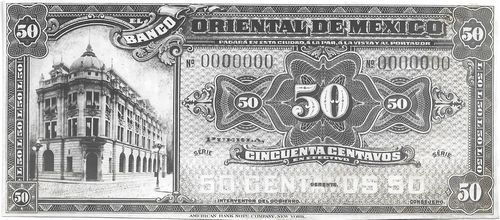
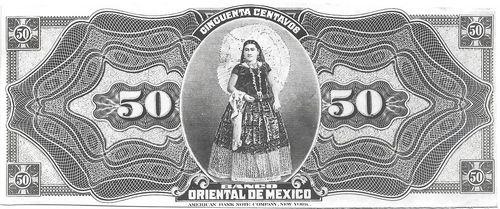
Blackmore received the models on 30 March, but the bank had again changed its mind and now wanted a vignette of the Aztec Calendar Stone (without the Indian) on the 50c reverse.
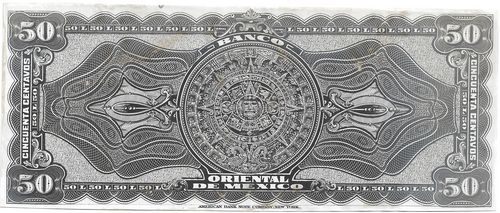
Proof, with '50's in corners different to the final note
On 7 April the bank confirmed it was placing an order but wanted a delay until it received new $1 and $2 models in a different colour. It also completely changed its specifications for the 50c note: a different size, with a (totally inappropriate) vignette of ex-President Porfirio Díaz, though the ABNC expressed reservations about the nature of and time needed to fulfil the order. Partly because of these, on 28 May the bank changed the vignette of Díaz for that of Estevan de Antuñano which appeared on their other notes. The bank made some changes to, but finally approved, the $1 and $2 models on 13 July and placed an order for 1,000,000 $1 and 250,000 $2 notes (intended to start replacing the American Book & Printing Company notes, with more orders to follow).
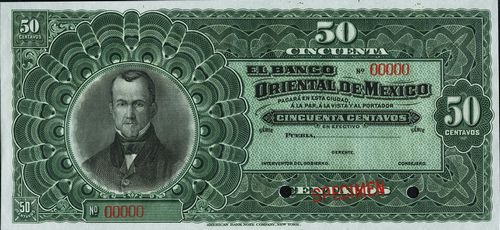
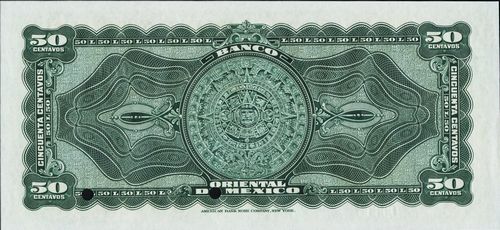
| Date | Value | Number | Series | from | to |
| June 1914 | 50c | 1,000,000 | 1 | 1000000 |
The 50c notes were shipped via Puerto Mexico in six consignments from 10 September to 15 Octoberon 10 September, per S.S. “Morro Castle”, 30,000 notes (000001-030000); on 19 September, per S. S. “Bayamo”, 100,000 notes (030000-130000); on 24 September, per S. S. “Mexico”, 250,000 notes (130001-380000), on 1 October, per S. S. “Esperanza”, 250,000 notes (380001-63000), on 9 October, per S. S. “Morro Castle” 250,000 notes (630001-880000), and on 15 October, per S. S. “Monterey” the final 120,000 notes (880001-1000000). but by 23 January 1915 the manager of the express company in Mexico City still had no knowledge of their whereabouts (three boxes finally turned up in August 1915). Shipment of the $1 and £2 notes was planned to begin in the first week of November but problems with the plates put that back until late November, and because of the troubling circumstances in Mexico the bank then asked the ABNC to delay shipment. The notes languished in the ABNC’s vaults until 17 January 1925, when they were finally cremated.
The bank also ordered some $1 and $2 notes. These were printed in July 1914 and the ABNC engraved a special vignette of the bank building (C 1387).
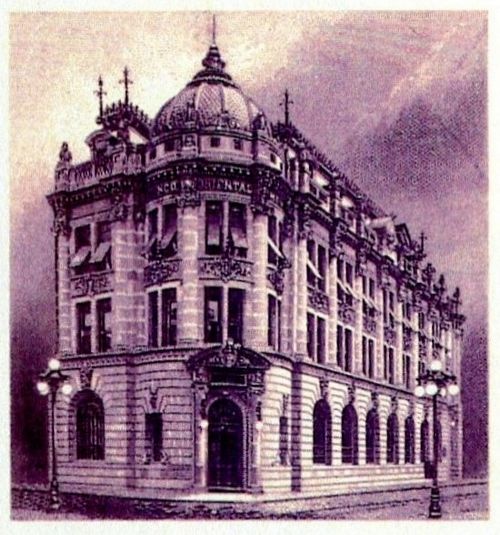 However, they were never delivered to the bank before it lost its concession and were destroyed in December 1924.
However, they were never delivered to the bank before it lost its concession and were destroyed in December 1924.
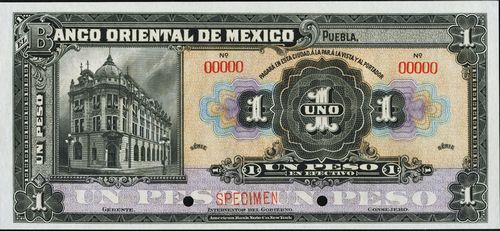
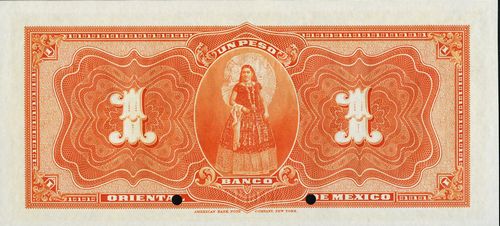
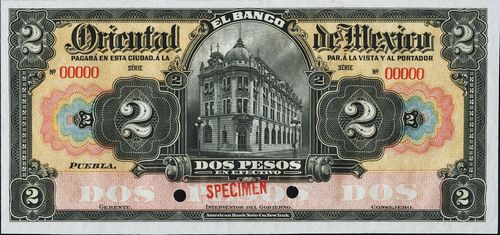
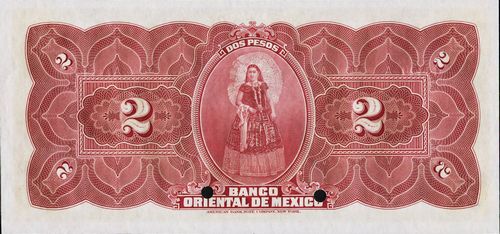
| Date | Value | Number | Series | from | to |
| July 1914 | $1 | 1,000,000 | 1 | 1000000 | |
| $2 | 250,000 | 1 | 250000 |
In December 1913 the bank's notes, which were the commonest out-of-town banknotes in Mexico City, were being exchanged by the Descuento Español, a subsidiary, on about the same terms as the other state banks with the Banco Central MexicanoThe Mexican Herald, 19th Year, No 6682, 17 December 1913 so there was less difficulty experienced in handling them than with the notes of the other state banks. One central commercial establishment had a notice posted to the effect that it would accept notes of the Banco Oriental de Mexico in payment of purchasesThe Mexican Herald, 19th Year, No 6683, 18 December 1913.
When Carranza’s Comisión Reguladora e Inspectora de Instituciones de Crédito inspected the bank, the bank declared that it had a little more than $16,600,000 in metallic funds and so was within the limits of the Ley general but in September 1915 the Comisión’s inspector disagreed and two months later withdrew its concession, despite the efforts of major military and political dignitaries. This was a major loss for the Spanish colony and businesses in central Mexico, as well as for the Banco de Descuento Español and the Banco Español Refaccionario, and the numerous branches in Oaxaca and Chiapas.
On 30 December 1915 the Procurador de Justicia Militar, en funciones de Procurador General de la Nación, General Ignacio Noris, consigned to the Juzgado 3o de Instrucción Militar, under the charge of Coronel Moisés Huerta, the casework concerning the fraudulent balance that the bank had presented to the Secretaría de Hacienda y Crédito PúblicoEl Pueblo, Año III, Tomo I, Núm. 430, 1 January 1916.
Among the agreements that the Secretario de Hacienda, Alberto Pani, made with the representatives of the various old banks was one to unify the operations of the Banco Oriental de México, Banco de Descuento Español and Banco Español Refaccionario, since they shared directors and shareholders. Then, on 18 December 1925, Pani signed an agreement with Juan de Dios Robledo, manager of the Banco Oriental de México, to redeem the federal government’s debt with the bank with government bonds and resolve outstanding disagreements and claims.
Finally, on 30 August 1930 president Pascual Ortiz Rubio issued his decree for a Comité Liquidador to dissolve the old banks of issues.
